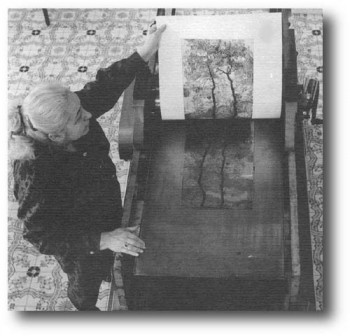Federica Galli
Profile
Etcher
A prominent figure of the art of engraving in Italy, Federica Galli was born in 1932 in Soresina – a village just outside Cremona.
Straight after the war, in 1946, she convinced her parents to enrol her at the Artistic Lyce-um in Milan and in 1950 she went on to attend the Academy of Fine Arts of Brera, from where she graduated four years later with a diploma in painting.
She began engraving in 1954 - “Il paese dell’Alberta”- experimenting with etching, a tech-nique she never abandoned for the rest of her life. In 1966 she married the journalist, Giovanni Raimondi – editor-in-chief of the Corriere della Sera – and began to embark on a densely packed programme of cultural trips that took her to the most important European capitals, and to coun-tries where the art of engraving is less deeply rooted. This was also the year in which she matured the conviction that engraving was the technique in which she expressed herself most effectively and started to apply herself exclusively to this art form, producing over eight hundred different subjects. Starting from her early personal exhibitions – the first one took place in 1960 in Milan – she met with the favour of public and critics alike. In the space of a few years, she could count on the support of some of the most authoritative critics of her time: Franco Russoli, Mario de Micheli, Giovanni Testori – who was to follow her closely until he died - Mina Gregori, Gian Al-berto dell’Acqua, Roberto Tassi, Renzo Zorzi, Carlo Bo, Daniel Berger (Metropolitan Museum of New York), Gina Lagorio, Giuseppe and Francesco Frangi, Marco Fragonara, Giorgio Soavi and David Landau (Oxford University).
She obtained the most prestigious institutional acknowledgements given to any contempo-rary artist: she was the first living artist to be invited to exhibit at the Fondazione Cini in Venice - 1987 with a collection dedicated to the lagoon city - ; at the Civic Museum of Palazzo Te in Man-tua - 1987 - ; at the Castello Sforzesco in Milan - 1988 - ; in the Imperial Archive of the Forbid-den City, Wag Fung gallery, - 1995 -. Collectors of her works include people of culture from Italy and elsewhere, individuals known for their cultivated passion for the graphic arts, comprising – just to mention some of the most famous: Dino Buzzati, Leonardo Sciascia, Francois Mitterand.
An extensive and exhaustive testimony of her works may be viewed at the Ala Ponzone Civic Museum of Cremona, in the Bertarelli Collection of the Castello Sforzesco in Milan, at the Villa Reale of Monza close to Milan.
Between 1954 and 2008, Federica Galli engraved over eight hundred plates with a focus on three principal themes: landscapes, trees and cityscapes. Her landscapes are mainly those of the Lombardy plain, with poetic descriptions of its characteristic farmsteads: adding up to about fifty artworks.
The urban views are those of Milan and Venice, cities that held a special meaning in the life of Federica Galli, who expressed her gratitude in the form of a vision that is perceptive and honest, but never banal.
Her passion for nature, combined with a capacity to bring forth its most enchanting as-pects, are revealed in over one hundred plates. Her notorious technical skills enabled her to surmount obstacles that are formidable for engravers, such as the representation of snow and nocturnal scenes, without ever succumbing to affected mannerisms.
The artist has dedicated a collection of works to the most important Monumental Trees of our peninsular, with over sixty plants selected for their historical, naturalistic or aesthetic interest. An exceptionally beautiful collection.
Federica Galli, who passed away on 6 February 2009, has entrusted her artistic legacy to a Foundation bearing her name, which was set up on 17 July 2009 in Milan. This Foundation, whose directors and their relative functions were designated by Ms Galli herself, pursues the ob-jective of safeguarding the name and work of this artist who has left her mark on the Italian art history of the last fifty years. The Board is chaired by Lorenza Salamon, who operates alongside Flavio Arensi (critic and art director of Palazzo Leone da Perego in Legnano), Ivana Iotta (cura-tor of the Civic Museum of Cremona), Franco Grechi and Alberto Galli.
Fundamental bibliography:
- Roberto Tassi; Trentanove vedute di Venezia, Fondazione Cini, edizione Olivetti, Milano 1987
- Daniel Berger e Gian Alberto Dell’Acqua, con scritti di Giovanni Testori e Harry Salamon, Fe-derica Galli, in occasione della mostra retrospettiva Castello Sforzesco di Milano, edizione Fabbri, Milano, 1990
- Marco Fragonara, Federica Galli, catalogo generale 1954-2003, edizione galleria Oreste Bellinzo-na, Milano, 2003
- Flavio Arensi, Federica Galli, l’incanto dello sguardo, in occasione della retrospettiva a Villa Reale a Monza (Mi), Allemandi & c. editore, Torino 2008
Presentation
Video
Selected exhibitions
More than 325 exhibitions between 1958 and 2009
In Italy: Milano, Cremona, Ferrara, Firenze, Parma, Trento, Palermo, Brescia, Verona, Udine, Vicenza, Trieste, Valenza Po, Cagliari, Caltanisetta, Piani d’Ivrea, Genova, Monza, Crema, Ales-sandria, Salice Terme, Suzzara, Padova, Cuneo, Saronno, Merano, Savona, Lucca, Fidenza, Impe-ria, Saluzzo, Aosta, Como, Reggio Emilia, Torino, Savognin, San Martino di Mozzate, Roma, Nuoro, Lissone, Busto Arsizio, Voghera, Asti, Cantù, Biella, Oggiono, Bologna, Vigevano, An-cona, Borgo Manero, Zara, Lecco, Corbetta, Rho, Giussano, Venezia, Brescia, Mantova, Magen-ta, Bordighera, Rovigo, Luvignano, Legnano, Monza, Sondrio, Carpi, Bergamo, Casalpusterlengo, Cernobbio, Cesena, Feltre, Parabiago, Cortina d’Ampezzo, Lodi, Corfù, Susa, Pordenone, Chera-sco, Goito, Soncino, Folgarida, Sperlonga, Vaprio d’Adda, Bolzano, San Virgilio di Marebbe, Mezzolombardo, Borgio Verezzi, Livorno, Chiavari.
Abroad: Johannesburg, Cape Town, il Cairo, Bogotà, Coria, Spalato, Barranquilla, Cartagena, cit-tà di Guatemala, Montreal, Lugano, Santa Marta, Flims Waldhaus, Flüelen, Bensheim, Parigi, Bel-grado, Zagabria, Dubrovnik, Basilea-Riehen, Londra, Singapore, Seoul, Kuala Lampur, Pechino, Atene, Murialdo.
